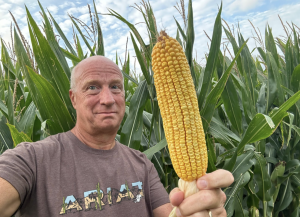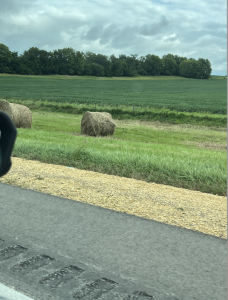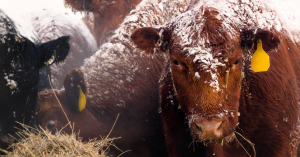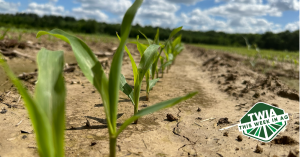Seeing is believing. And I’m convinced the recent WASDE reports on crop production aren’t lying. Over the weekend we took my son to college. Our scenic journey through farm country – beauty is in the eye of the beholder, after all – took us deep into the Corn Belt. The projected 2024 corn yield in the Prairie State is 225 bushels per acre. Judging by what I saw from the road, and up-close in the fields, I’ll take the over. Upon pulling into my mother’s driveway, I made a beeline for our cornfield and pulled the first ear that caught my eye. It was a whopper: 20 rows wide and 42 long. Not every ear was like that, mind you, but there were enough like it to convince me that the field was headed for astro numbers. Our drive throughout eastern Iowa, and a few stops to look and see, suggested their projected record corn yield of 209 bu/A is more than doable. Soybeans also look great. Based on what friends in the Delta are telling me from their combines, best-ever crops appear to be the norm below the Mason-Dixon line, too. Nationwide, we’re looking at projected record highs for both corn (183.1 bu/A) and soybean (53.2 bu/A) yields. One thing’s for sure. US farmers are really, really, good at growing grain. Where it’ll all go remains the question.

Can’t imagine why corn grows so well in Illinois? This is from our family farm. I stopped digging at 20 inches. It all looked the same.

My Tennessee corn is done. Done growing, that is. It reached black layer last week, which indicates physiological maturity. How can you tell? Pull a kernel off the ear and use your thumbnail to scratch the tip of the kernel. If the scratching reveals a black spot, then the corn has reached maturity. This black layer of compressed cells forms a barrier between the kernel and ear, preventing water or nutrients from entering or exiting the kernel. At this point, the kernels contain about 35% moisture. They must dry down to 15.5% moisture to be sold. So when will we harvest? Much depends on the weather and how fast the kernels dry. Hot, dry, windy days accelerate the process. It’s not uncommon for kernels to dry 0.75-1.0 points per day in the heat of the Delta. So we should be harvesting in early- to mid-September.

The 116-day corn hybrid I planted reached physical maturity in 106 days. A seed product’s “days to maturity” listing is an inexact prediction. A more accurate measure is growing degree days. Environmental factors contribute heavily to how fast a crop matures. This season we’ve had an abundance of heat and sun, which hastens maturity.
Last week a new world soybean yield record was set. Don’t shed any tears for the previous record holder. It’s the same guy. Alex Harrell shattered the record he set just last year by 12 bushels, cutting an astounding 218 bushels per acre on his red clay soil. The 34-year-old southwest Georgia farmer grew a new Pioneer Z variety (4.9 maturity) planted at 110,000 seeds per acre, on 30-inch rows, using strip-till, poultry litter and irrigation. And yes, he used humic and fulvic acid, delivered in-furrow and via a 3-by-3 system. I remember in the early 2000s when Missourian Kip Cullers ushered a soybean revolution, upping the ante multiple times over a five-year span that culminated into a then mind-blowing 160 bushels per acre yield in 2010. I still remember that famous photo of him holding a soybean plant so loaded down with pods that you thought he was holding multiple plants. Georgia grower Randy Dowdy had a similar run from 2016-2019, raising the bar to 171, then 190. Now the baton appears to be passed to Harrell.
Say you’re in Iowa without saying you’re in Iowa. When you see the roadsides baled, that’s a strong indicator you’re in the state famous for farming.

Our trip this past weekend included visits to Casey’s General Store, Hy-Vee, Culver’s, a country music concert, the National Toy Tractor Museum, small town dinners, several friendly conversations with strangers, church, saying and hearing “I’m sorry” multiple times even if I or others didn’t do anything, constantly waving to passers-by while driving down country roads, endless conversations about farming and rural life with family and friends, cool nights, and scouting crops. Or as we call it, Midwest living.
Related Posts

This Week in Ag #48
The popular TV series Yellowstone, along with the western lifestyle craze, has certainly romanticized ranching. It seems like everyone wants to be a rancher, until there’s real-world ranching stuff to do. This week’s bone-chilling Midwestern weather brings back memories. Notice I didn’t say fond memories. When you have livestock, they require care every day. Utility tractors

This Week in Ag #65
“Anticipation” is a famous song from Carly Simon (which also became the advertising anthem for Heinz ketchup). But it could also be the theme for how farmers feel from the moment they drop their planter. My first year of farming on my own, I waited over three nail-biting weeks for my soybeans to emerge. This year,

This Week in Ag #8
Farmers love to grow corn. Only twice in modern history has corn not held the title of the most-grown crop in the USA. That was in 2018 and (if you count it) 1983, when the government’s PIK program artificially swayed planting practices. Spurred by record fertilizer prices, many projected soybeans would overtake corn last year

